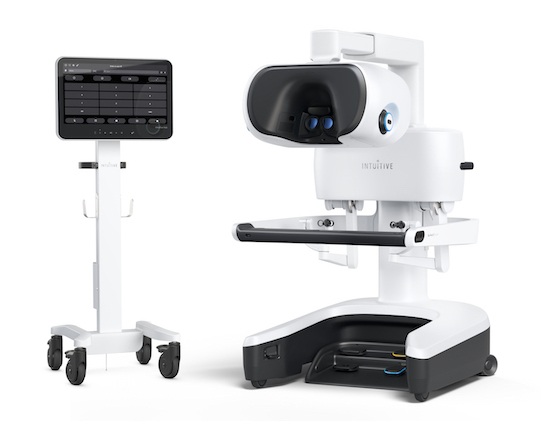Transforming Surgery to Enable Better Outcomes
Surgeons at Centennial Hills Hospital Medical Center use the da Vinci 5® surgical system, an advanced robotic platform that enables them to perform complex procedures with more flexibility and precision than ever before. This may result in less pain, scarring, trauma and blood loss than other surgical procedures so that people can potentially return to work and daily activities more quickly.*
Robotic Procedures
The da Vinci 5® surgical system is being used to help surgeons perform various procedures, including:
- Prostate procedures
- Gynecologic procedures
- Kidney surgery
- Head and neck surgery for tumors and other issues
The da Vinci 5 surgical system
 Da Vinci 5 is Intuitive’s most advanced and integrated platform, designed to transform surgery to enable better outcomes, efficiency and actionable insights. The system can be used for minimally invasive surgical procedures for urology, gynecology, thoracic, and general surgeries.
Da Vinci 5 is Intuitive’s most advanced and integrated platform, designed to transform surgery to enable better outcomes, efficiency and actionable insights. The system can be used for minimally invasive surgical procedures for urology, gynecology, thoracic, and general surgeries.
With more than 150 new design innovations, da Vinci 5 expands upon core da Vinci system features, including wristed instruments, 3DHD visualization, intuitive motion and an ergonomic design. The surgeon is completely in control of the robotic-assisted da Vinci system, which translates their hand movements into smaller, more precise movements of tiny instruments inside the patient’s body.
Key enhancements include:
- First-of-its-kind Force Feedback technology, which can reduce the amount of force on tissue, based on preclinical data comparing High to Off settings for retraction
- Optimized vision with truer colors, higher image resolution and the most realistic da Vinci 3D image
- Better ergonomics for greater surgeon comfort and surgical viewing
- More than 10,000x the computing power of da Vinci Xi to deliver actionable insights
The da Vinci 5 system is a future-ready platform with advanced capabilities today and abundant capacity to incorporate ongoing enhancements. The system was designed to blend seamlessly into program workflows.
Minimally-invasive and robotic advantages*
Both robotic surgery and laparaoscopic surgery are known as minimally invasive procedures. In both procedures, small incisions are used, which may result in less post-operative pain, reduced blood loss, less need for blood transfusions and a potentially faster recovery time. The two major drawbacks of conventional laparoscopy (without the use of robotic instrumentation) are that it relies on the use of rigid, hand-held instruments, and visualization is provided by a standard 2D video monitor rather than a 3D field. While standard laparoscopic surgery is performed using small incisions, the surgeon's depth of field, dexterity and precision may be variable.
Potential benefits of minimally invasive robotic surgery over open surgery include:
- Shorter hospital stay (one day in most cases versus three to five days)
- Significantly less pain post-operatively (often only over-the-counter pain medications are required)
- Quicker recovery and return to normal activities (one to two weeks versus six to eight weeks)
- Fewer complications and less risk of infection
- Less scarring: Small, dime-sized incisions versus a six- to eight-inch scar.
Best Candidates
The best candidates for robotic surgery are chosen on an individual basis by your doctor. Ask him or her about robotic surgery and whether or not your diagnosis and situation will lend itself to robotic surgery.
Get a physician referral
If you need a referral to a surgeon who performs robotic surgery at Centennial Hills Hospital Medical Center, call our free physician referral service at 702-388-4888.
*Individual results may vary. There are risks associated with any surgical procedure. Talk with your doctor about these risks to find out if robotic surgery is right for you.
